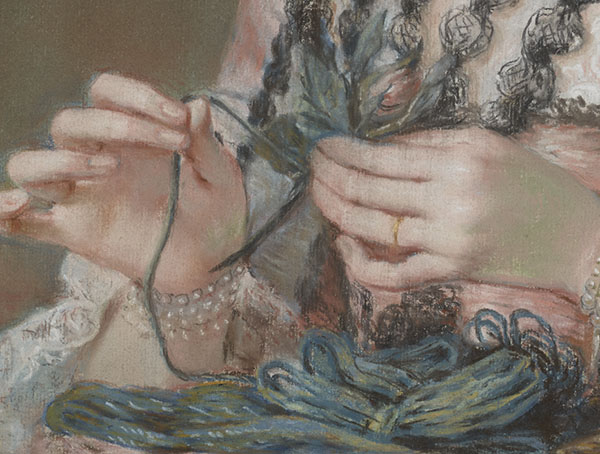Newly acquired portraits tell the unusual story of Hoare and Hoare, the banking heir and the portraitist who depicted him

Left: Henry Hoare, “The Magnificent,” of Stourhead, about 1750–60, William Hoare. Pastel on paper. The J. Paul Getty Museum. Right: Susannah Hoare, Viscountess Dungarvan, later Countess of Ailesbury, about 1750–60, William Hoare. Pastel on paper. The J. Paul Getty Museum
“Whether at pleasure or business, let us be in earnest, and ever active to be outdone or exceeded by none, that is the way to thrive.” —Henry Hoare, 1755
In 1739–40, British banking heir Henry Hoare, who had abandoned his drinking and hunting ways in favor of more intellectual pursuits, embarked on a Grand Tour to study fine art in Italy, developing a lifelong love of classical and neo-classic art. He returned to the family seat, Stourhead in Wiltshire, with crates of significant paintings and continued to collect, assembling one of the most notable collections of his day. An accomplished businessman (the oldest bank in England, C. Hoare & Co. is in operation to this day), Mr. Hoare applied his professional high standards to matters of taste, including collecting, architecture, and landscaping. His estate at Stourhead was such an extraordinary example of home, art collection, and gardens that his acquaintances were known to call him “Henry the Magnificent.”
Artist William Hoare (no relation, c. 1707–1792), was a founding member of the Royal Academy of Arts and one of the leading portraitists of his day, a natural choice for a man of taste such as Henry Hoare. After studying in Italy, William Hoare settled in Bath, England, where the spa seasons supplied him with a constant influx of important sitters, including the Prince of Wales. William Hoare formed a friendship with Henry Hoare and became a frequent guest at Stourhead. William Hoare’s daughter, Mary (1744–1820), also an artist, even married Henry Hoare’s nephew.

Detail of the original frame of Henry Hoare, “The Magnificent,” of Stourhead, about 1750–1760, William Hoare. J. Paul Getty Museum
The J. Paul Getty Museum has acquired two pastel portraits dating to about 1760 of Henry Hoare and his daughter Susannah by William Hoare, which are currently on view in the Museum’s South Pavilion. Both pastels are in their original matching carved gilt-wood frames, probably after designs by the great English Rococo furniture designer Thomas Chippendale.
The portrait of Henry is one of the finest pastels William created in his career. In exceptional condition, the likeness is drawn in rigorous profile, vividly capturing Henry the Magnificent’s commanding personality. Henry Hoare’s decision to be portrayed in strict profile, in the manner of ancient Roman coins, speaks to the influence of classical antiquity for both men.
Susannah Hoare, Viscountess Dungarvan, later Countess of Ailesbury, looks out from her pendant at the viewer. She wears a widow’s cap, having lost her husband Charles Boyle, Viscount Dungarvan, in 1759. Her hands are busy winding yarn around a rose.

Detail of yarn in portrait of Susannah Hoare, Viscountess Dungarvan, later Countess of Ailesbury, about 1750–1760, William Hoare. J. Paul Getty Museum
Though grand and elegant, the pair are also poignant as Susannah was Henry’s only living child at the time. In his extraordinary but tragic life, Henry Hoare outlived both of his wives and, eventually, all six of his children. Susannah, his eldest daughter from his second marriage and the longest living, preceded him in death by two years at the age of 51. Henry Hoare was 80 years old when died in 1785, an exceptional age for a man of his time.
Susannah Hoare kept the portraits in her home when she became the Countess of Ailesbury in 1761. Created as a pair, the father and daughter portraits have stayed together ever since. Now they hang in the Getty Museum’s South Pavilion where they are on exhibit through January 2014.




Hi Amy,
Could Susannah be winding yarn around the stem of the rose to make a nosegay, rather than balling the yarn? Isn’t Henry’s profile less strict than those on classical coins, because his left eyelid show across the bridge of his nose?
Thanks for drawing attention to these interesting new pastels.
Cheers,
David
Hi David,
Thanks for your comment. Good eye, yes there is a rose in Susannah’s hand! I’ll make that change to the above, thanks. And while Henry’s profile may be less strict than a classical coin, I do think it conveys that influence.
-Amy
The 1824 Will of Thomas Sedgwick Whalley of Mendip Lodge Somerset and Portland Place Bath records a painting in crayon by ” the late Mr Hoare of his late dear wife when she was a little girl “( this would have been either Augusta Heathcoate or Elizabeth Jones as he was married three times but at the time of his will his third wife, from whom he was legally separated, was still living ) being left to a Catherine Richards of Taunton.